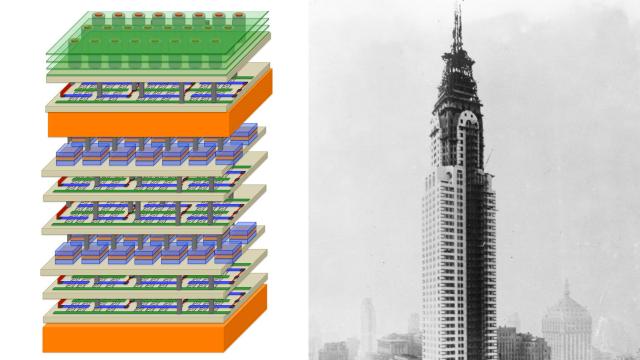Tall buildings were the vanguards of the modern world. They completely changed how cities functioned, bringing forth totally new social and urban systems. The reasons they changed cities are surprisingly similar to the reasons they may change the way computer memory is built.
Imagine a skyscraper. Each floor might contain a different company or — one might be apartments, while another might hold offices, while another might serve as a grocery store. Now think of the same things — homes, offices, and stores — spread out in a suburban grid.
The tall building is a much more efficient way to use space, right? There, you don’t need a car to move between your home and office. There are no traffic jams. There’s a shorter distance to move in general. Even moving between skyscrapers can be done without a vehicle. As the historian Rosemarie Haag Bletter put it, the skyscraper “affected the scale and density of central cities more drastically than railroads or schools”. It changed the world forever by adding a new dimension to the built world.
The same reasoning applies to computer chips today. Inside your computer, you’ll find memory chips laid out horizontally like houses and malls around a suburban community — all connected by long lengths of wire, which shuttle data like cars on streets. It’s not a very efficient way to move information around inside your computer, at Stanford News explains this week.
“Suburban-style layouts create long commutes and regular traffic jams in electronic circuits, wasting time and energy,” writes Ramin Skibba. But, as Skibba explains, creating “skyscrapers” out of multiple chips hasn’t been a great solution either — mostly because fabricating them at super-hot temperatures damages the lower-level chips that have already been made.

Lower Manhattan in 1921. Topical Press Agency/Getty Images.
Skibba was writing about a project at Stanford called N3XT, which will be featured in a special issue of IEEE this month. Led by Subhasish Mitra and H.-S. Philip Wong, N3XT does something very simple with very complicated nano-scale engineering: It stacks memory vertically, like buildings’s floors, and connects them with “millions of electronic elevators that can move more data over shorter distances that traditional wire.”
The result? An “electronic super-device” that’s 1000 times faster than conventional memory.
As the duo explained last year, there are a lot of moving parts in actually achieving this, but for starters, they created a new way to manufacture transistors out of carbon nanotubes, or CNTs, that can be squeezed en masse onto a wafer:
They created what amounts to a metal film that acts like a tape. Using this adhesive process they lifted an entire crop of CNTs off the quartz growth medium and placed it onto a silicon wafer. This silicon wafer became the foundation of their high-rise chip.
Paired with a new type of memory Wong invented, called resistive random access memory or RRAM, the N3XT system moves more data with less energy — and without traffic jams caused by wires or heat. “Just as skyscrapers have ventilation systems, N3XT high-rise chip designs incorporate thermal cooling layers,” Skibba explains.
It’s an entirely new type of thinking on computer memory. But what’s so interesting about the project, in another sense, is how closely it mirrors a macro-level revolution in architecture that took place more than a century ago.
Macro-scale skyscrapers depended on a new way of using existing materials like steel and glass to create a foundation that could support the force of many floors above it. Similarly, the N3XT micr-skyscraper depends on a new way of using materials, like carbon-nanotubes, to stack chips in a way that doesn’t damage any of the lower levels. And just like their behemoth predecessors, these chips may have the power to radically reshape the systems our world runs on.
We’ll have to wait to hear more in IEEE, but it’s an exciting project that we’ll be watching closely. You can read more at Stanford News.
